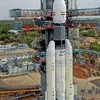The next frontier: Agnikul Cosmos bets on 3D-printed rocket engines for affordable space launches
Agnikul Cosmos leverages 3D-printed rocket engines for cost-effective space launches, aligning with India’s affordable space mission legacy. Its sub-orbital test flight showcases innovation and positions the startup for future successful orbital launches.
India’s space sector has only grown and grown.
Helmed by the Indian Space Research Organisation (ISRO), it has consistently punched above its weight, achieving remarkable feats on shoestring budgets—be it the Mars Orbiter Mission (Mangalyaan) reaching the Mars orbit in its maiden attempt or Chandrayaan-3 soft-landing on the moon.
These low-cost projects have propelled India to become a top player in space geopolitically.
The government too has opened the space sector to private players. It has liberalised the sector through Indian Space Policy 2023, which enables private enterprises to carry out end-to-end activities, and by allowing 100% foreign direct investment to lower entry barriers.
Chennai-based finds itself in a sweet spot. The spotlight is on India’s affordable space launches, and it is building on this legacy by demonstrating cost-effective launches using 3D-printed rocket engines. Its Agnilet engine, first test-fired in 2021, is the world’s first single-piece 3D-printed semi-cryogenic rocket engine.
After four failed attempts, the space tech startup made history on May 30, 2024, with a triumphant sub-orbital test flight of its launch vehicle, Agnibaan SOrTeD (SubOrbital Technological Demonstrator), powered by seven Agnilet engines. It became only the second private space tech firm to achieve rocket launch success after Skyroot Aerospace’s groundbreaking Vikram S rocket launch in November 2022.
Agnikul Co-founder and COO Moin SPM, brimming with post-launch excitement, tells YourStory, “Five years ago, nobody would have believed that 3D printing a rocket engine was possible. Now that we have proven the technology can actually work, that’s the first validation.”

Design: Nihar Apte
3D-printed rocket engines
Over the past few decades, 3D printing has found numerous use cases—from optimising designs for medical devices to the aerospace industry standardising 3D printing into toolkits.
In the space tech industry, 3D printing has found wider use in rockets manufacturing. Companies such as Rocket Lab and Relativity Space have been at the forefront of this technology, with Relativity Space producing the Terran 1 rocket—an entirely 3D-printed rocket. Some partially 3D-printed rockets have already reached space.
Their advantage lies in customisation and efficiency. 3D printing enables the manufacturing of complex, single-piece engine components, reducing weight and the number of potential failure points compared to traditionally welded parts. It also streamlines production, potentially lowering costs and lead times.
Both Agnikul and Skyroot are leveraging 3D printing’s potential to create lighter, more adaptable, and potentially more affordable launch vehicles. While Agnikul has launched a test vehicle with fully 3D-printed semi-cryogenic engines, Skyroot has successfully test-fired a 3D-printed cryogenic engine.
Moin explains that 3D printing was a “game changer” for Agnikul, reducing the time to ready a rocket engine from around 10 months to three days.
“It takes three days to print an engine. And in those three days, you can determine whether it's a qualified engine or not because the machine itself detects any errors in the formation of the layers,” Moin remarks.
“We knew that the first engine we designed might or might not work, but we couldn’t afford to spend 10 months of our operational time developing an engine,” he adds.
The engine is printed using Inconel, which is a family of nickel-based superalloys known for exceptional heat and corrosion resistance. They are widely used in high-temperature and harsh environment applications.
“From a cost point of view, conventional manufacturing would have cost an estimated Rs 80-90 lakh. Because we 3D-printed it, it just cost us around Rs 10 lakh,” he says, adding that the cost can be as low as a tenth of conventional rockets and the company doesn’t need to maintain an inventory.
After the successful launch to the edge of space, the startup is now planning to fly higher.
“Too many emotions...the energy from that day has been infectious,” says Moin, adding that the company is now focusing on its orbital vehicle, which is the next step towards an orbital launch.
By 2028, the startup plans to launch 50 rockets a year.
First orbital flight
Orbital launches achieve enough velocity to stay in orbit around the planet, while sub-orbital launches reach space (past the Karman Line, about 100 km up) but do not maintain enough speed to orbit the planet and typically return to Earth relatively quickly.
Agnikul plans to achieve orbital launch within the next 9-12 months, aiming to deploy multiple payloads into space, Moin shares, with a rocket thrice the size used in the suborbital test.
The IIT Madras-incubated startup is targeting a launch altitude of 300-700 kilometres above Earth’s surface. These launches will be into low Earth orbit (LEO), the region closest to Earth where most satellites and the International Space Station operate.

Design: Nihar Apte
The company has validated the software, guidance algorithms, navigation and control systems, avionics packages, and flight termination systems, but still needs to validate stage separation and clustering of engines, which will be tested on the ground soon.
Moin says once the firm completes these tests, particularly for the liquid propulsion engines, which behave similarly in ground tests and actual flights, it will have the confidence to proceed with flight tests. Stage separation of the two-stage launch vehicle will also need to be demonstrated in flight.
Customisable and affordable launches
Agnibaan, derived from Sanskrit meaning ‘arrow of fire’, is a two-stage launch vehicle designed to carry payloads of up to 300 kg to orbits approximately 700 km above Earth’s surface. Its first stage can accommodate 4-7 Agnilet engines, with the second stage powered by the Agnilet vacuum-optimised engine. It also offers an optional third ‘baby’ stage residing within the payload fairing.
Agnikul is also working on a consistent pricing model across payloads weighing between 30-300 kg.
“We offer a unique proposition to our customers. For a 30 kg payload, we launch with four engines; for a 100 kg payload, we use seven engines. Our goal is to maintain a flat cost curve,” remarks Moin.
Agnikul reportedly plans to charge about 20-25% less than SpaceX’s $275,000 rate for a 50 kg payload. ISRO’s PSLV launch services range from $10,000 to $15,000 per kg.
Moin explains that rockets carry multiple payloads during a launch. In 2017, ISRO made a record by launching 104 satellites on a single mission. However, the primary customer’s payload and launch preferences take precedence.
“The initial launch needs to be matched with a real commercial launch where the company is able to place the satellites in the required orbit. Achieving commercial success would be a real test and once achieved they will have a bright future,” says Anil Joshi, Managing Partner of Unicorn India Ventures, which has space tech bets.
Customers bringing business
“In this industry, there is a lot of respect for flight heritage. Once you demonstrate capability, many customers are willing to work with you because there is such high demand for space access,” explains Moin.
He adds that the firm has received significant interest from numerous potential customers and is actively engaging with four for orbital launches. The startup is also in contact with customers building constellations, which involve repeated sets of launches.
Agnikul has received inbound interest from geographies like Europe, Australia, and Japan. It is also planning to get a foothold in the US market.
“In terms of business, it’s a good position to be where we are...we need to push to make sure that we convert all the leads that we have,” Moin says, adding that the space industry offers a “more or less pay upfront model” which is a “good thing”.

Design: Nihar Apte
ISRO’s established reputation for affordability and success in the global space ecosystem benefits all customers, Moin says, adding that in the next ten years, 15-20% of the global space market share could come to India.
According to a report by research and consulting firm Quilty Space, about 20,000 satellite launches are planned till 2030.
India sits at a prime spot in the global space economy with innovative low-cost solutions. Its space sector, which accounted for approximately 2.1% of the global space economy in 2020 amounting to $9.6 billion, is set to grow to $13 billion by 2025 at a compound annual growth rate (CAGR) of 6%, according to an ISpA-E&Y report.
The growth will be fuelled by the opening up of the commercial space economy and the participation of startups including Pixxel, Dhruva Space, and Bellatrix Aerospace to drive innovation in both space launches and downstream technologies like remote sensing.
Innovation beyond 3D-printing
Agnikul aims to operate non-sequentially and concurrently address the market needs, which includes scaling its production capacity. It is exploring rocket reusability and recovery, which can reduce the cost of missions.
“Now we understand why they (SpaceX) did reusability—because it takes a lot of heart to build something and throw it in the ocean,” remarks Moin, noting that the company is looking at a 2-3 year timeline to explore reusability.
“Reusability makes sense when you're at scale because to bring something back you need to carry more fuel,” says Vishesh Rajaram, Managing Partner of Speciale Invest, an early-stage venture capital firm. It was the first firm to invest in Agnikul.

Design: Nihar Apte
Agnikul has secured a total of $67 million in equity funding, including a Series B round of $26.7 million in 2023. Moin explains that startups are perpetually in a “mode of funding”, and Agnikul adheres to this philosophy. It is preparing to raise another round of funding to drive scalability.
“Often we get asked, what gives you the confidence that India can innovate at a global level, and fight competition. Agnikul is a standing example for that being a possibility from India,” adds Rajaram.
(Cover image and infographics designed by Nihar Apte)
Edited by Kanishk Singh









